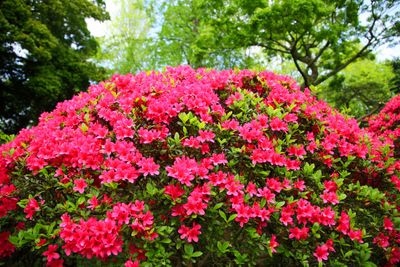About Azalea Mulching
Before you choose a mulch for azaleas, it’s important to understand the concept of mulch. Mulch is a verb that means placing a layer of material on the top of the soil around plants to hold in moisture and keep down weeds. It’s also a noun referring to the material you can use. Almost anything capable of being layered can work as mulch, including newspaper, pebbles, and chopped dry leaves. Many gardeners think organic mulch is best, and it does seem to be best for azalea mulching. Organic mulches are materials that were once alive, like pine needles, organic compost, and dried leaves. Organic mulches work best as mulch for azaleas since they disintegrate into the soil over time, enriching it and increasing drainage.
Reasons for Mulching Azalea Bushes
Azaleas can grow into good-sized shrubs, with some cultivars shooting up taller than the average gardener. No matter how tall they grow though, their roots are quite shallow. These plants need slightly acidic soil with excellent drainage, since they don’t like wet feet. Still, azaleas only thrive if the soil around their roots is moist soil. That’s where mulching azalea bushes comes into the picture. Azalea mulching means you can water less but offer your plants consistently moist soil, since the best azalea mulches prevent moisture from evaporating in heat.
How to Mulch Azaleas
If you are wondering how to mulch azaleas, you’ll be happy to learn that it’s an easy task. You’ll need a good, organic mulch. The best azalea mulches include pine needles and dried, chopped oak leaves. These are organic mulches that do the job keeping the moisture in the soil, regulating soil temperature and keeping down the weeds. They also add a little acidity to the soil. Mulching azaleas involves mounding about 3 or 4 inches (8-10 cm.) of one of these mulches in a wide circle around the base of the plant, covering the root area. Don’t extend the mulch right up to the plant; keep the mulch a few inches (8 cm.) from the stems and foliage. It’s best to mulch soil that is already moist. You can do this by waiting until after a rain or watering the soil before mulching. Keep your eye on how the mulch is doing and replace it when it breaks down, usually at least once or twice a year.
